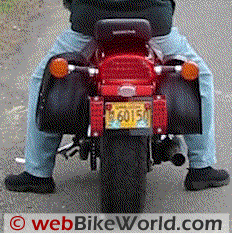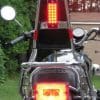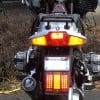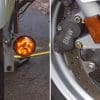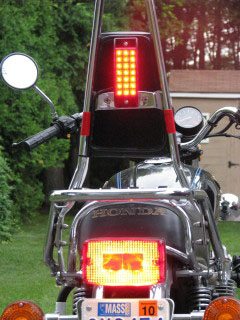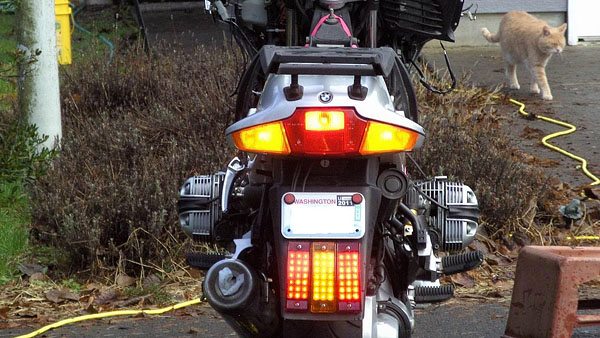The subject of auxiliary and LED brake lights has been a very popular topic with webBikeWorld visitors for many years.
We started reporting on LED lights before they were being used on motorcycles.
This was back when LEDs were rare, expensive and not very bright — and when most of the LED lights that were available had to be specially adapted for motorcycle use.
LEDs have evolved quite a bit since then and the prices have dropped to a point where it is not uncommon to find them installed as original equipment on many different vehicles, including large trucks and trailers.
Based on what I see on the road, LED brake and tail lights seem to have overtaken their incandescent forebears as original equipment on the big rigs (although we don’t have any data on this).
Those truck LEDs are big, bright and bold, in case you haven’t noticed, and we’ve often wondered how they would work — and look — on the back of a motorcycle.
So this article by author David G. sort of brings us full circle to yet another LED experiment; this time it’s adapting a truck LED light for motorcycle use.
David found a good deal on a couple of big, honkin’ LED truck lights and he wired ’em up to see what happens. This is his report.
Introduction
Supplemental brake lamps, a.k.a. “third brake lights”, are a continuing item of interest among motorcyclists.
Granted, the most important improvement one can probably make is to install supplemental driving lights or a headlight modulator to increase the motorcycle’s visibility to oncoming traffic, but brake lights seem to hold more interest with bikers.
This is curious, because, according to statistics, fatalities from rear strikes are a fraction of frontal crashes (although there is no data on non-fatal rear-enders).
Even so, it pays to ensure following drivers notice you, especially when slowing for a turn or when coming to a stop.
My interest in rear-end visibility peaked after a scary highway near-miss.
The sound of skidding tires and the image of an SUV growing larger and larger in my mirrors was a real attention-getter, I can tell you. Fortunately, the wannabe assassin stopped short with about a meter to spare.
As a result, one thing I have done is to adopt my motorcycle instructor’s favorite quote relating to why one should invest in high-quality safety equipment: “It’s cheaper than skin grafts or a body cast.”
Why Better Brake Lights?
By way of background, I live in a rural area on the scenic North Oregon Coast of the U.S., and we get more than a million visitor vehicles each year.
These tourons — i.e., “tourist-morons” — frequently spend more time scoping out scenic vistas or looking for a place to pee than watching the road.
And because we’re a retirement destination, we also have a large population of elderly residents. It is not unusual to see a car piloted by a shrunken, snowy-haired person of indiscernible gender who is barely able to see over the dash.
The point is that city or country, we all face multiple threats from inattentive, impaired and distracted drivers, so anything you can do to make you and your motorcycle visually evident is a smart move.
LED Brake Lights to Use
After my little scare I dutifully read all of the webBikeWorld and other articles on after-market brake lighting, which gave me some great information on the advantages of LEDs.
Several reviews and web crawls later, I came away wondering if the small LED assemblies marketed as “third brake lights” really have enough horsepower for the twin threats of blind geezers and oblivious tourons.
It is hard to imagine that a few tiny lamps are effective at 100 feet or more…
In addition, a recent headlight experience has colored my thinking about the role of size in lighting. A friend recently installed a pair of 2-1/2 inch, 55 watt halogen driving lights with round projector lenses on his motorcycle.
But during daylight hours and from a distance, I discovered that they appear only marginally better than the stock amber turn/running lights.
So with that in mind, I outdid him by opting for a pair of 3-1/2” by 5” off-road reflective lamps for my bike.
With identical 55 watt bulbs, the reflectors provide a two- to three-time larger “optical footprint” for oncoming drivers. The moral of the story? “Size matters”.
I decided to also apply that lesson to the rear of the bike, and I supplemented my stock brake light with something in between the tiny little munchkin lights and those big, ugly units you see on trucks and buses.
But, as I discovered, most of the industrial-grade LED assemblies I found were either round or oval, and nearly all require flush mounting.
I was just about to give up the notion of an acceptable solution when the “6-Inch SuperBrite Red LED” marker light shown here caught my attention.
These sealed, ultra-bright, vibration resistant, surface-mount units feature 21 LEDs per unit with each bulb sporting its own personal reflector. At the time this article was written, they were on sale for $15 each, a great price for what you get.
When the lights arrived, I attached one to a battery to check out brightness.
The resulting painful blast of red was surprising – and just what the doctor ordered!
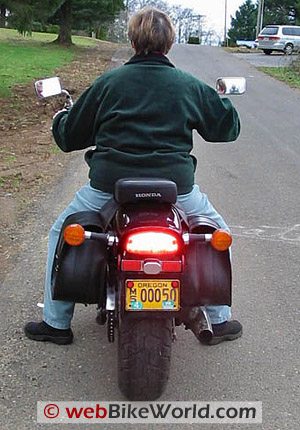
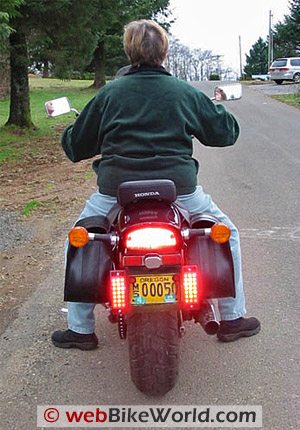
In comparison to other auxiliary brake lights, the 6-Inch SuperBrite Red LEDs are quite large and about the size of a stock motorcycle brake light lens.
Since you can’t be too rich, too famous or have too much visibility in traffic, I opted to use two of these suckers.
The combination of their size, their wire leads (rather than a protruding plug) and their surface mount design provide natural location flexibility, such as:
- License Plate: A single LED light mounted above or below the tag effectively doubles your brake light transmission. Two units, for a total of 42 LEDs, on opposing sides of the plate was my preference.
- Saddlebags: Vertically or horizontally mounted lights on rear panels. Soft bags may need an internal stiffener. Slant or angled bags won’t work without a wedge shim to make the light vertical – you’ll see why below. Most owners, however, won’t be interested in putting screw and wire holes in pricey luggage.
These are not those wide-broadcast LED units with a premium price tag; rather, maximum light is spread in a 21-degree “cone of light” (see illustration below).
Outside of this area, to about 45 degrees per side or 90 degrees total, the lamps and reflectors deliver light at about the level of a regular tail light – still visible but lacking that desirable, eyeball-frying intensity.
However, I found this performance issue to be a minor downside when compared to the multiple advantages of these lights.
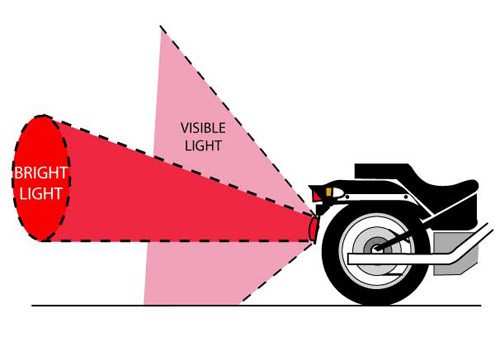
By positioning the units so they’re pointed slightly upwards, drivers in close-following RVs and commercial trucks will get their fair share of red light. In a darkened garage, the intense central cone of illumination projects very crisply on a wall or closed door.
Shim the light mount so bottom edge of the “cone of light” is broadcast at the same height as your tail light. You could also point a pair slightly outboardReview,Reviews,lights
, retaining a 10 degree overlap, to push effective cone width to 30 degrees.
One final installation tip: The license mount on my Honda 600 VLX and many other motorcycles is a flimsy, molded plastic assembly, so a lightweight mounting plate was needed.
A visit to my local sign shop yielded a thin, feather-light, rigid, double aluminum sheet laminate over a plastic core. There are two brands — U.S. made Dibond, generally available in white only, and British made Alupanel which has a full spectrum of colors to pick from including chrome.
Alupanel sheets have matching color on both surfaces, one side is matte and the other is gloss. There is usually scrap material available for next to nothing, check with an area sign person for availability and color selection.
Automotive flash modules can be utilized; see the Miata.net site for a good set of instructions. Incandescent flashers may require a resistor addition for LEDs.
Other LED specific circuits allow you to program flashes, timing and full-ON sequences. Talented do-it-yourself types can even obtain a schematic for a user-adjustable module. I added a $20 “flash-flash-on” circuit found on eBay.
Where to Buy the Flasher
Q. “I’m writing regarding David G’s article on the 6” LED truck lights. I’ve been looking all over trying to find the flash, flash, on circuit he mentions but have had no luck. Can you please suggest a manufacturer or other source for these? I already ordered the lights.”
A. The current offering from Rearalert (RearAlert brake flasher module $15.99 or this brake flasher module for motorcycles $16.99) is actually cheaper and appears to be almost the same – search on “brake flasher”.
It is probably based on the same #555 integrated circuit as are similar units but the “de-acceleration” term is misleading.
My definition of “de-accelerator” sensor involves a stress triggered switch or strain gauge to power a light without touching the brake which is not what they describe in the text of this unit. (More motorcycle brake flasher and alert modules here).
The only apparent difference is that mine has a trimmer/rheostat (versus wire jumper) built into it so you turn a screw to shorten/lengthen flashing. I also opted to branch off the brake wire so the main light remains solid at all times.
Finally, given the plethora of flashers out there with price points ranging from $16 to $50, a review of flasher approaches might be a good future project for someone.
Summary
The 6″ SuperBrite LED Truck Lights function perfectly as a “third brake” light for motorcycles.
For urban and freeway environs, with their multiple driver distractions and sensory competitions, I view supplemental brake lights with flashers as a “must have” safety investment.
I expect these lights to go a long way toward keeping my ass out of a sling – literally.
Owner Comments and Feedback
See details on submitting comments.
From “S.F.” (04/11): “The sound of screeching tires behind me has stopped my heart more than once during my highway rush hour commute.
While seeking to improve the brake light visibility of my 1980 Honda CB750C, I found the above page; after considering various options, I decided to install the light.
It definitely is a significant improvement (photo below). It’s been on the bike for a year now and has held up perfectly…. And my heart seems to beat a little smoother.”
From “G.P.” (01/11): “I was inspired by the article “Truck LED Lights for Motorcycles so I added three of the 6 inch SuperBrite truck marker LEDs to the rear fender of my 2002 BMW 1150RT — two red LED brake lights, and one amber LED running light in the middle.
I used both Posi-Tap and Scotchlock connectors to tap into the existing brake light and tail light wiring, and both types of connectors have worked well so far.
Then I installed Run-In-Lites for the turn signals. However, I substituted H1157 halogen bulbs for the 1157 bulbs that came with the Run-n-Lites.
The H1157 halogen bulbs are much brighter than the 1157 bulbs, both in running light mode (a continuous 15 watts, instead of 8 watts) and blinking a turn signal (an intermittent 50 watts, instead of 27 watts).
Please see the first attached picture for the rear lights. For front running lights, I found these Super Bright LEDs’ “Fixed Angle Beehive Marker Lamp” LEDs to be an inexpensive alternative. Now I hope the cages can see me, even in the daytime!”
Editor’s Note: Be careful with the halogen bulbs, they burn so hot they can easily melt the housing. See our review.
From “P.A.”: “You can never have too much light coming off the back end (and often overlooked, the sides) of a motorcycle and anything which flashes the brake lights when brakes are applied is even better.
I installed a double set of brake lights into the regular brake light housing (twice as bright) of my Gold Wing 1800 and a Kisan brake modulator, both are available from Electrical Connection.
And, my bike is yellow and, I have wide bands of the reflective light strips sewn into the sides of the legs and on the back of my Motoport Kevlar (review) riding gear.
As for the front end, the Gold Wing is famous for having very bright headlights, however, I also run high intensity yellow fog lights all the time and drivers tell me they notice me and that is exactly what I am seeking.
I also have a Kisan headlight modulator installed which I do not run all the time because it is too annoying to on coming traffic and anyone ahead, however I do turn it on when approaching intersections where oncoming or merging traffic may cross my path.
I feel a little more visible and that’s all good but do I feel safe from the “Gee I didn’t see you” crowd?
Never. I ride with the presumption that they really don’t see me and I ride accordingly. Defensively.
Other than wearing a full face helmet and Motoport Kevlar riding gear I cannot think of a smarter investment in personal safety for any rider than having more light (and modulating when brakes are applied) come off the back end of their bike.”
Response From the Author: Search eBay for “brake flasher”. The offering from Rearalert is your best choice and the price is right.
My original circuit was the “Electro Flasher” which carries a 90 day warranty.
Wouldn’t you know it….mine croaked after 100 days. It is notable that its failure did not affect the main brake lamp since I opted to branch off and isolate the supplemental components.
Two minor information updates are noteworthy:
One local biker opined that using a full time wig-wag flasher would garner even more attention. It sounds good at first blush but there is a problem — the purpose of rear lights is to communicate presence, actions and intentions.
If you bombard that following driver with a continuous riot of pulsating bright red lights, they may not notice a flashing amber turn signal and pass you on your turning side. Ouch!
This is why a short flashing sequence, which then goes to solid, is preferable.
From “S.M.”: “As a card carrying member of AARP, I must highly protest David G’s description of retiree’s as “shrunken, snowy-haired person of indiscernible gender who is barely able to see over the dash”.
If David hasn’t look at the statistics of people who are buying motorcycles, he will likely find that these people are a little more mature than the average population.
And must point out to Mr. G that he is going to resemble his own description in the future. He may turn into his own worst nightmare.
Actually, I suspect his comments are really a parody to setup the seriousness of the situation and looking for ways to avoid rear end collisions.
I appreciate his research on the use of non-motorcycle specific lighting solutions to bring better visibility to any bike.
While I’m not sure I would use his specific choices for auxiliary lighting, he has pointed out a direction that offers increased safety and reasonable costs.
Thanks to wBW and David for some good ideas.”
Dave’s Reply: Yes, my references to the elderly are a tad tongue-in-cheek as I am an AARPer, too.
I didn’t get my bike endorsement and first cycle until the tender age of 60 plus my regular riding partner, who is well over 70, has been riding for 50+ years.
We joke about getting special bike mounts to carry walkers which is tacit recognition that someday we will become part of the problem.
This doesn’t change the fact that there are way too many geezers who should have had their privileges lifted long ago…
From “G.M.”: “Thanks again for another great article, on a very interesting subject. The author mentioned his sphincter clinching experience that motivated his interest, and it reminded me of my favorite, and my only humorous, close call story.
This relates to why brake lights like this are needed.
If anyone wonders why I have a headlight modulator, I’ll be glad to tell them about the guy who turned left 15 feet in front of me, and how the Lord was with me that day, I’ll tell you. But I digress.
I started motorcycling on a Honda 100 Scrambler, maybe a 1972 model. I rode it back and forth to the church, where I was a college student “youth director” for the summer.
I oversaw young folks not yet old enough to drive, whose parents bought them real motorcycles. They rode 350’s to 750’s to the church parking lot, to go round and round. I got hooked.
Then I, the only legal driver, purchased my 100 Scrambler with my own good money, and my part time job.
On the way home one day, as a raw inexperienced rider, I stopped for a light turning from yellow to red. I settled in as the first vehicle at the light at the “wait” line, and then suddenly I heard the screeching brakes behind me.
I looked into the rear view to see a VW bug sliding toward me almost sideways, and swaying from right to left angles in a serious big time slide.
Your mind works extremely fast in such situations (especially if the Lord is your copilot), and running the math, it was clear that this car was not going to stop before striking me and my bike.
Once again, mind in highest possible and with help from above, I considered my options during the next 2 to 3 seconds. It came down to “Let’s Make a Deal”.
Door #1: If I tried to pull forward, I was likely to either give it too much gas and dart in front of the crossing traffic, who now had the green light.
Door #2: I was likely to kill it being too careful trying not to surge into on-coming traffic, and get hit because the bike had not moved far enough.
I decided on Door #: I picked up the 100 Scrambler, between my legs, and ran with it. I ran, more like waddled, forward just one bike length, looking pretty stupid I freely admit.
Thankfully, the crossing traffic was too stunned to move into the intersection, as I moved one bike length into their lane.
I looked back, and the VW’s bumper was six inches from my rear tire. I looked forward, and saw crossing drivers laughing hysterically in their cars.
I too, laughed, but only later when I told the story. I confronted the inattentive teenage girl driving the VW, who used the infamous and idiotic phrase: “I’m sorry, I didn’t see you”.
One useful bit of life lesson here: when you stop at a light, leave yourself some “wiggle” (or waddle?) room in front of you, in case you hear the squealing tires behind you.
BTW, I can’t begin to pick up my present bike, or any of them since the 100 Scrambler, but you can still roll or drive forward.
I already have some of the little flashing LED’s from Cycle Dynamics. These look like they would demand much more attention, and they’re cheaper, too.”


